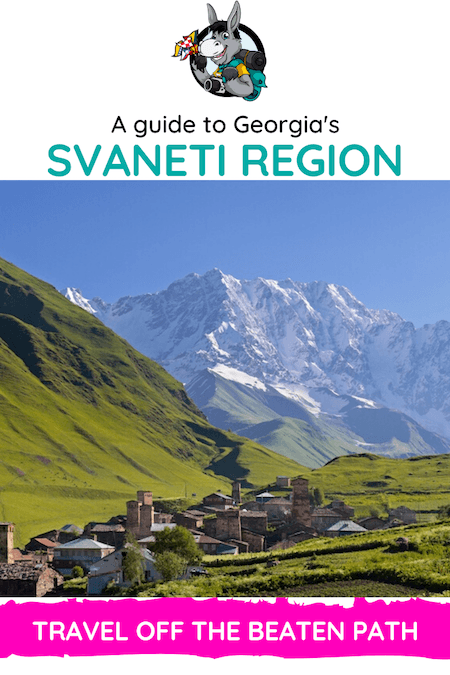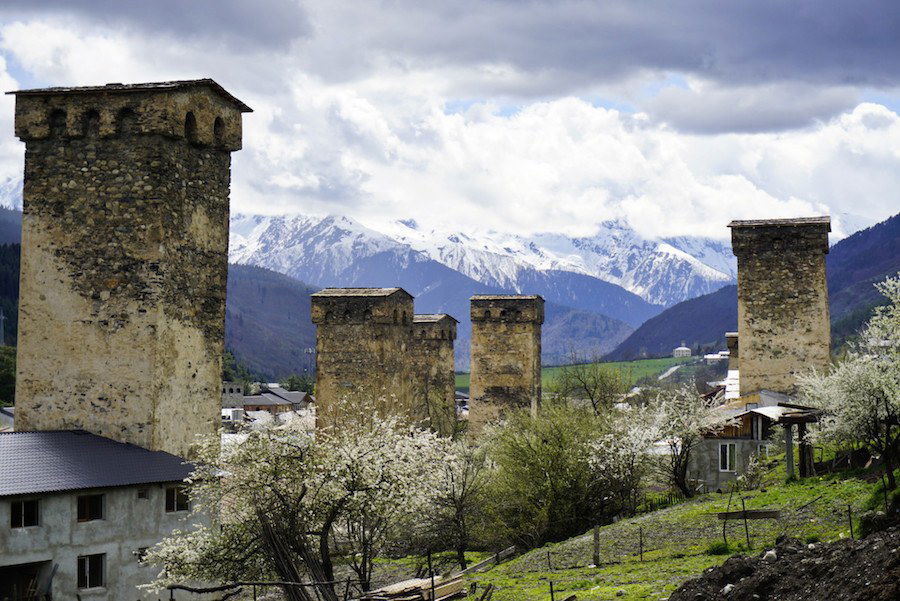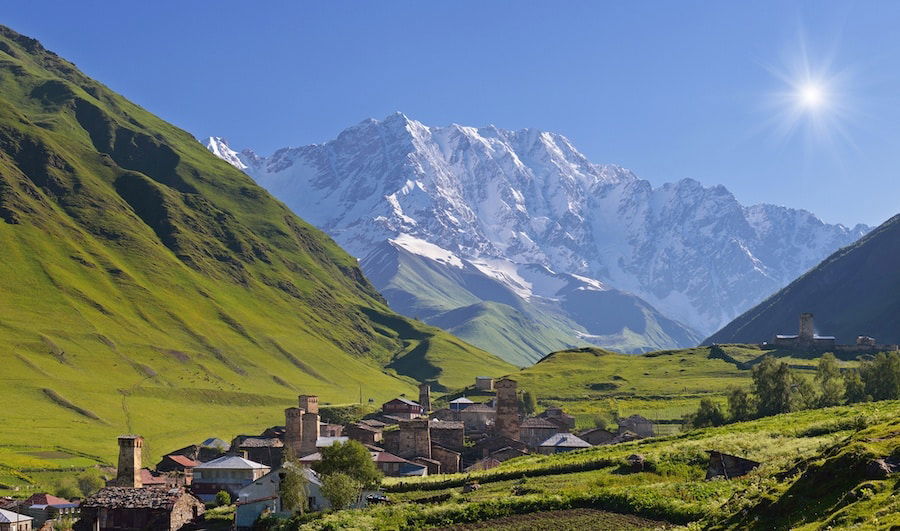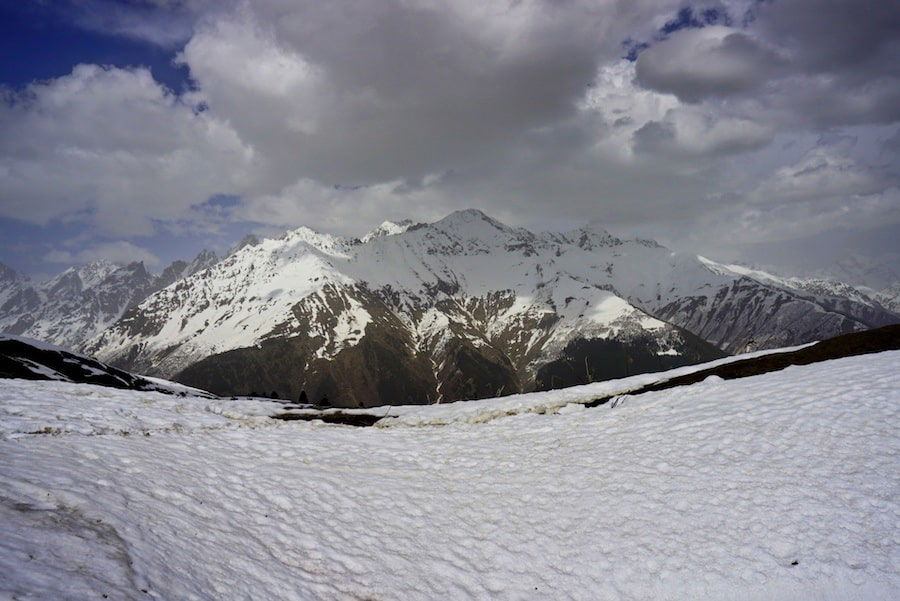Dozens of picturesque villages dotted in beautiful winding mountain roads, surrounded by the impressive Caucasus mountains – here is how to discover the Svaneti region, Georgia.

Dozens of picturesque villages dotted in beautiful winding mountain roads, surrounded by the impressive Caucasus mountain snowed peaks. Sounds idyllic?
Add to the mix a visit to Georgia’s capital of adventure, Mestia, which will have many hiking paths and amazing skiing opportunities waiting for you. Still not convinced? You’ll also get the chance to experience a unique and untouched culture, where people are friendly and the food is delicious. I bet I have your attention now.
Welcome to the Svaneti region, Georgia’s best-kept secret!

Georgia is still quite an off-the-beaten-path destination, although its capital, Tbilisi, is slowly becoming more known. Low-cost flights to Kutaisi are also putting the country on the travelers’ map. Even Batumi, in the Black Sea, has its specific audience –watersport fans and gamblers.
But the northern regions, those in the mountains, where Georgia meets Russia, are often forgotten. The north-east has a bit more of a spotlight because many tourists take a day trip from Tbilisi to Stepantsminda to visit the jaw-dropping Gergeti Trinity Church, a top-of-the-hill monastery with Mt. Kazbegi’s snowed peak in the background –one of the most beautiful monasteries in the Caucasus region. But the north-west, inexplicably, is still off the radars from most.
The Svaneti region is in a spot where the Caucasus mountain range divides Russia from Georgia and lies next to the breakaway region of Abkhazia. A winding road goes up from the Black Sea, surrounded by vegetation of everchanging colors. On one side, you’re greeted by snowed summits; on the other, a sturdy river creates occasional waterfalls to keep your attention. Only this picturesque mountain road is reason enough to highlight Svaneti in any Georgia travel guide, but there’s much more.
Five thousand meters of peaks surround the region, with deep valleys in between, where little towns have flourished. This meant living in extreme isolation, giving the Svan people a unique character. The remoteness was, in fact, so extreme that the region kept substantial autonomy until the 19th century, which allowed them to preserve their own culture, language, and traditions on a much bigger scale than anywhere else in the Caucasus.
As if the stunning nature was not reason enough to visit, the uniqueness of the people and their culture makes the Svaneti region one of the most interesting destinations in the country and, I’d dare say, in the whole continent.
Skip Ahead To My Advice Here!
What Not To Miss In The Svaneti Region, Georgia

Here are a few ideas to keep you busy in The Svaneti region.
Mestia
Even though Mestia is the capital of the region, it only has 1900 inhabitants. Regardless of the scarce population, it has been recognized as Georgia’s capital of adventure.
The valley that houses the town is mostly a rural area that features alpine meadows full of colorful flowers and roaming cows, pigs, and chickens, with the Mestiachala River running on the side.
You’ll likely be based here, so it’s hard to miss it. Still, leave some time to wander through the city. It has a weird mix of wooden mountain chalets and Soviet concrete buildings. In recent years, in an effort from the government to modernize the town, out-of-place structures have been conceived. The most prominent one is St. Nicholas’s church, but the one that caused outrage among the inhabitants was a modern sculpture of Queen Tamar. She ruled the country in Medieval times, but she was so beloved and cherished that she was crowned king (a big honor for a woman in her time).
For people-watching (and meeting), head to Laila. This restaurant in Seti Square is the place to be after a hard day of skiing/hiking. They have an outside terrace and serve some Svanitan specialties.
Svaneti Museum Of History And Ethnography
This small museum allows you to see some of the greatest treasures of Georgia. Since the region was hardly ever conquered, most of the country’s treasures ended up here over the years for their safety. The exposition displays icons and engravings, ornaments, jewelry, weaponry, textiles, and ethnographic pieces with the story of the Svan people.
Svaneti Towers
The Svanetian houses feature defensive stone towers called Koshi, which are an emblem of the region. They were erected mainly between the 9th and 12th centuries.
The houses were conceived as fortresses, offering protection to the owners and their livestock, in a place where the houses were too scattered to build a wall around them all, in true medieval style. So, each house had to be separately fortified.
About 200 survive these days, and most of them are still in use.
Ushguli

47 km southeast of Mestia, where the Enguri valley reaches Mt Shkhara, you’ll find this small village, just shy of 300 inhabitants.
Ushguli is made up of five tiny villages up the hill alongside the river: Murkmeli, Chazhashi, Chvibiani, Zhiviani, and Lamjurishi. The first one is set at 2060 meters and the last at 2200 meters. It’s said that it’s the highest permanently inhabited village in Europe. And it’s a UNESCO World Heritage Site.
It’s also said that Ushguli represents free Svaneti, “our people have never had princes” –they will all tell you. Even the name of the village tells this story: Ushguli comes from Georgian ‘ushishari guli,’ translated as ‘fearless heart.’ They’re proud to tell you the town served as a summer retreat for Queen Tamar, showcasing its importance in Georgian history.
There are two ways to get there: via a multi-day hike (see more on it below) or driving. If the hike is too much, or your time is limited, board a marshrutka (a Soviet-style minivan) for an organized return trip, or rent a private one if you’re traveling with a larger group. Don’t drive yourself. 2/3 of the roads are unpaved and in very poor condition.
Just a bit above the last village, you’ll be greeted by Mt Shkhara, Georgia’s highest peak, at 5193 meters.
You can climb the mountain, hike up to the foot of the glacier, or just stop at a viewpoint at the beginning of the trial for gorgeous vistas.
Cable Car To Mt Zuruldi
Whether you visit in winter or summer, taking the cable car up to Mt. Zuruldi is a great way to get a panoramic view of the city and the surrounding mountains.
This chair lift is the lower cable car connecting Mestia to Hatsvali ski station. There’s a restaurant on top, and, in summer, you can do a short and easy hike (6 km round trip) to the Mentashi transmitter, where you’ll get 360° views of the valleys and peaks around, including the breathtaking Mt Ushba, known as the “Matterhorn of the Caucasus.”
Eat Svanetian Food
The main characteristic of the local cuisine is the Svaneti salt, a blend of herbs, including dry coriander, cumin, red pepper, fennel, salt, and garlic. It’s responsible for the delicious taste of the region’s dishes and an important historical trade good.
The main dishes of Svaneti are kubdari (a seasoned meat pie), tashmijabi (boiled potatoes and cheese), fetvraal (the Svanetian take of ubiquitous khachapuri, with millet flour added to the cheese filling on top of dough), and kartoplaar (another khachapuri-like pie but with potato and cheese filling). You’ll also quickly find every other Georgian specialty, like khinkali, lobiani, nigvziani badrijani, pkhali, and churchkhela (known as the Georgian snickers).
Brands We Use And Trust
When To Visit The Svaneti Region

It’s beautiful all year round, but you can choose your dates according to your interests. For winter sports, there will be snow from mid-December to March. If your thing is hiking, then the best time is between June and September.
I’d personally recommend May and October. Even though this destination is not too popular, the towns are tiny, so only a few hundred people feel like a crowd. Therefore, it’s much nicer to have space on the trials and enjoy nature with peace and quiet. The shoulder seasons are perfect. During autumn, you’ll be treated to the beautiful colors of the changing foliage. In spring, mind the fact that you might face a bit of challenging weather. With the right hiking shoes and common sense, you’ll be fine, even if you come across some snow on the hikes (which will only make them look prettier).
The Svan People
If there’s a need to describe the people from Svaneti in one word, it’d be proud. They will mention, at the first chance they get, that they have never been conquered. They have a reputation as fierce warriors yet live humble lives in harmony with nature.
Due to their ferocious spirit, they managed to retain significant autonomy until the 19th century, preserving their own unwritten language –mostly unintelligible from Georgian–as well as their own culture and traditions.
One of the customs of the Svan people was blood revenge. They are not happening anymore, but it was a common practice. The film Dede, based on a real story from Ushguli, features this tradition. Pub & Cinema Dede plays the movie daily, and you can enjoy it over a cold beer. With most of the actors being from the town, and because it was filmed there, it’s easy to be transported into the ’90s (where the story happened) and into the mindset of the Svans. It might sound odd, but a movie, in this case, is the perfect way to end a day in the mountains.
Skiing In Mestia

There are a few great places to ski in Mestia; don’t miss the opportunity to ski in the Caucasus mountains, Europe’s highest range.
Tetnuldi Ski Resort
Tetnuldi ski resort, on the northern, western, and southwestern slopes of Mt Tetnuldi, 20 km east of Mestia, will welcome skiers of any level from mid-December to mid-April.
It has 13 km (8 miles) of slopes, with a short green one and much longer blue and red ones. Its vertical drop from the summit to the base is 895 meters (2969 ft).
Hatsvali Ski Resort
Hatsvali ski station is smaller and lower, ideal for beginners and intermediate skiers. It’s located 8 km south of Mestia but can be reached from the city via cable car. It has a shorter season –from late December to late March–but even lower prices.
It features 5.6 km (3.6 miles) of pistes, with a beginner’s slope, one blue and one red, with a vertical drop from the summit to the base of 480 meters (3018 ft).
Backcountry Skiing
Ski touring is very popular since Svaneti offers a significant number of wild, untouched slopes. Even though Georgia’s premier ski resort is Gudauri, the ones who enjoy going off-piste will have a better time in this region.
If you don’t want to try it on your own, there are plenty of organized multi-day tours that go through the mountain slopes to tiny villages where you stay overnight and be treated with local specialties and chacha (a Georgian spirit) to keep you warm.
The Best Hikes Of The Svaneti Region
Before attempting any of the hikes, look carefully at the weather conditions. You are likely to find snow in some of the paths, even in late spring. Check with the Tourist Information Office in Mestia if you have any doubts. They can also provide you with a hiking map. It’s also a good idea to have an offline trail map (maps. me is free and offers detailed maps and tracks).
Don’t forget to pack sturdy hiking shoes, no matter what time of year you visit. Remember, you’re up in the mountains, so the nights get cold even if the summer days are hot. Be prepared for sudden temperature changes. It’s always a good idea to carry a lightweight jacket. The first layers are also practical.
Mestia To Ushguli
The textbook multi-day hike of Georgia. The recommended pace is to tackle this well-marked trail in 4 days, every day going up to a ridge, with 400 to 800 meters of altitude gain, and down to a village where you’ll find a guesthouse to sleep in.
Day one goes from Mestia to Zhabeshi, a 14 km walk through the Mulkhura valley. The second day takes you from Zhabeshi to Adishi, a 10 km trek with 800 meters of ascent that leads to a ridge with stunning views of the valleys on both sides. On day three, you’ll go from Adishi to Iprali, 15 km following and crossing the ice-cold Adishi River and up the valley. Finally, on the fourth day, after 10 km, mostly on the car road, you’ll get to Ushguli.
The Cross Over Mestia And The Koruldi Lakes
This hike takes you up to a steep hill overlooking Mestia, where you get a 360° view of the whole valley and to the higher peaks hidden behind the hill. It’s about 800 meters of ascent to get to the top of Tshakazagari mountain. They’re two different approaches: one around the hill in a zigzag 4WD track –longer but easier; and a much steeper one in an average hiking path surrounded by nature.
Even if you’re not too fit, take the latter. You can make a ton of photo stops (and you will want to even if you don’t need to catch your breath). Still, you’ll be walking up from the city, passing through several Svaneti towers, trekking in the middle of a forest, going across a stream of water with stunning everchanging views.
Next to the cross, there’s a wooden shelter you can climb, where you can relax and enjoy the panorama. Up to here, it’s about 3.5 km, which should take around two and a half hours.
If you want to continue hiking, follow the signs to Koruldi Lakes through the ridge of the mountain. From the cross on is much less steep (although it goes steadily up), so the hardest part is done! It should only take you an extra hour and a half. Count on the whole day for this hike, or start super early if you have other plans for the afternoon.
Mestia To Chalaadi Glacier
This is a long but easy hike. If you start from Mestia, it is around a 22 km round trip, most of it is reasonably flat. Only the last 1.5 km from a footbridge across the river is uphill. You can take a taxi or rent a bike to get to this point and hike only the demanding but nice-looking part until the foot of the glacier. Remember that there’s a lot of glacial scree and other loose rock, so sturdy shoes are a must.
Ushgui To Shkhara Glacier
From Ushguli, take the dirt road up the mountain. The whole path should showcase the Shkhara glacier in the distance, at the foot of the mountain that shares the name. It’s 8 km, with 540 meters of elevation gain, to the glacier, walking at the bottom of the valley. The climbing route to Georgia’s highest summit starts from the foot of the glacier, so you’ll see people with tons of equipment walk alongside you –don’t be scared; you’re not underprepared; they have a different “walk” in mind.
Move This Adventure To Your Inbox & Get An Instant Freebie

No spam. Unsubscribe at any time.
Practical Information

How to get to Mestia
- Fly: From Tbilisi (Natakhatari airport) and Kutaisi, there are inexpensive flights to Mestia. These are 15-seat airplanes with a few flights scheduled weekly if the weather allows them. They tend to sell out fast, so plan ahead. Check the availability here.
- Night train: From the capital, you can take an overnight train to Zugdidi. It leaves Tbilisi at 21:50 and reaches the city close to the coast at 06:05. From there, you’ll need to transfer to a marshrutka (a Soviet-style minivan) to Mestia. The first one is synchronized with the train. The trip takes about three and a half hours, with a stop for coffee on the way.
- Marshrutka: You can take a minivan directly to Mestia from Tbilisi, Kutaisi, or Zugdidi (and from Batumi, too, during summer). If you’re starting from anywhere else in Georgia, head to Zugdidi and Mestia.
- Drive: Driving in Georgia is an adventure on its own, but up to Mestia, you should be fine since the whole way is paved –drive slowly and defensibly. Once you get there, park the car and forget about its existence. The roads further up (like the one to Ushguli) are disastrous, only for the prepared locals or a sturdy 4WD.
Accommodation In Mestia
Accommodation ranges from backpacker hostels to 4-star hotels, but mainly you’ll find guest houses. This is great to meet locals and be treated to the most amazing Georgian cuisine. Make sure they offer breakfast – it’ll be the best way to make sure you’ll have the energy for all the adventures you’ll have!
Enjoy the trip to the Svaneti region; I wish you safe travels!


I have been in Georgia last year and really help me with that!